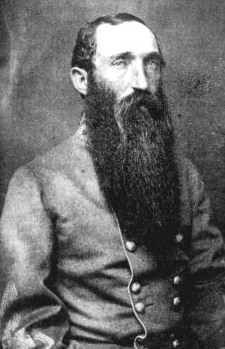- Albert G. Jenkins
Infobox_Politician
name = Albert Gallatin Jenkins
 |250px
|250px
width =
height =
caption = Representative Albert G. Jenkins
birth_date = birth date|1830|11|10|mf=y
birth_place = Cabell County, Virginia
residence =
death_date = death date and age|1864|5|21|1830|11|10|mf=y
death_place =Battle of Cloyd's Mountain
office = House of Representatives
salary =
term_start = 1857
term_end = 1861
predecessor =
successor =
constituency =
party = Democrat
religion =
occupation =
majority =
spouse =
children =
website =
footnotes =Albert Gallatin Jenkins (November 10, 1830 – May 21, 1864) was an attorney, planter, representative to the
United States Congress andFirst Confederate Congress , and a Confederate brigadier general during theAmerican Civil War . The commander of abrigade ofcavalry from what becameWest Virginia , he was mortally wounded at theBattle of Cloyd's Mountain nearDublin, Virginia .Early life and career
Jenkins was born to wealthy
plantation owner Capt. William Jenkins and his wife Jeanette Grigsby McNutt in Cabell County, Virginia, nowWest Virginia . At the age of fifteen, he attended Marshall Academy. He graduated from Jefferson College inCanonsburg, Pennsylvania , in 1848 and fromHarvard Law School in 1850. Jenkins was admitted to the bar that same year and established a practice in Charleston, before inheriting a portion of his father's sprawling plantation in 1859. He was named a delegate to theDemocratic National Convention in Cincinnati in 1856, and was elected as a Democrat to the Thirty-fifth andThirty-sixth United States Congress es.Civil War
With the outbreak of the Civil War and Virginia's subsequent
secession , Jenkins declined running for a third term and resigned from Congress in early 1861. He returned home and raised a company of mounted partisan rangers. By June, his company had enrolled in the Confederate army as a part of the 8th Virginia Cavalry, with Jenkins as its colonel. By the end of the year, his men had become such a nuisance to Federal interests in western Virginia that GovernorFrancis H. Pierpont appealed to PresidentAbraham Lincoln to send in a strong leader to stamp out rebellion in the region. Early in 1862, Jenkins left the field to become a delegate to the FirstConfederate Congress . He was appointed brigadier general August 1, 1862, and returned to active duty. Throughout the fall, his men performed well, continuing to harass Union troops and supply lines, including the vitalBaltimore & Ohio Railroad .In September, Jenkins' cavalry raided northern
Kentucky and West Virginia, and briefly entered extreme southernOhio nearBuffington Island , becoming the one of the first organized Confederate units to enter a Northern state. In December,Robert E. Lee requested that Jenkins and his men transfer to theShenandoah Valley .After spending the winter foraging for supplies, he led his men on a raid in March 1863 through western Virginia. During the
Gettysburg Campaign , Jenkins' brigade formed the cavalry screen forRichard S. Ewell 's Second Corps. Jenkins led his men through theCumberland Valley intoPennsylvania and seized Chambersburg, burning down nearby railroad structures and bridges. He accompanied Ewell's column to Carlisle, briefly skirmishing with Unionmilitia at theBattle of Sporting Hill near Harrisburg. During the subsequentBattle of Gettysburg , Jenkins was wounded on July 2 and missed the rest of the fighting. He did not recover sufficiently to rejoin his command until autumn.He spent the early part of 1864 raising and organizing a large cavalry force for service in western Virginia. By May, Jenkins had been appointed Commander of the Department of Western Virginia with his headquarters at Dublin. Hearing that Union Brig. Gen.
George Crook had been dispatched from the Kanawha Valley with a large force, Jenkins took the field to contest the Federal arrival. On May 9, 1864, he was severely wounded and captured during the Battle of Cloyd's Mountain. A Union surgeon amputated Jenkins' arm, but he never recovered, dying twelve days later. He was initially buried in New Dublin Presbyterian Cemetery. After the war, his remains were reinterred at his home in Greenbottom, nearHuntington, West Virginia . He was later reinterred in the Confederate plot in Spring Hill Cemetery in Huntington.Memorialization
, commemorating his service during the Gettysburg Campaign. [http://www.campcurtin.org/Jenkins%20Monument%201.jpg]
References and links
*Evans, Clement A., "Confederate Military History", 1899.
* Tagg, Larry, "The Generals of Gettysburg", Savas Publishing, 1998, ISBN 1-882810-30-9.
* Warner, Ezra J., "Generals in Gray: Lives of the Confederate Commanders", Louisiana State University Press, 1959, ISBN 0-8071-0823-5.
* [http://bioguide.congress.gov/scripts/biodisplay.pl?index=J000081 Congressional biography]
* [http://www.wvculture.org/history/journal_wvh/wvh8-1.html West Virginia Division of Culture and History biography]
* [http://www.archaeologychannel.org/content/video/greenbottom.html Ghosts of Green Bottom]Notes
Persondata
NAME= Jenkins, Albert G.
ALTERNATIVE NAMES=
SHORT DESCRIPTION= Confederate Army general
DATE OF BIRTH=
PLACE OF BIRTH=
DATE OF DEATH=
PLACE OF DEATH=
Wikimedia Foundation. 2010.
